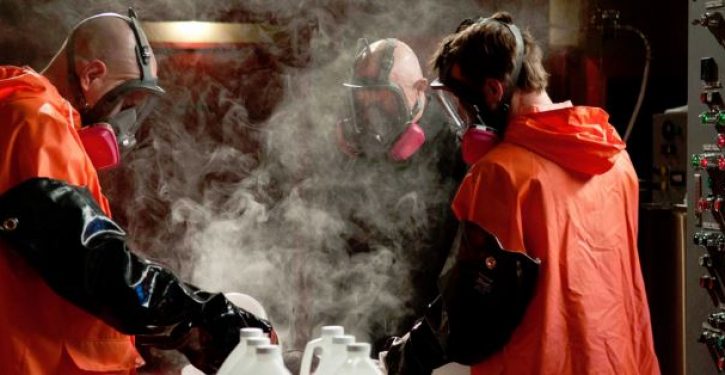
Hunger is rising in Afghanistan in the aftermath of its fall to the Taliban, killing people through starvation, even as American allies remain stuck there, reports the Washington Examiner:
According to a famine warning group , Afghanistan will reach crisis levels of acute food insecurity between October and January. Though the United Nations’s World Food Program will provide food aid to 15 million Afghans per month until next March, the Taliban will likely remain involved in aid distribution .
But tens of thousands of American allies still awaiting Special Immigrant Visas or refugee referral processing are facing another winter with no employment, security concerns, rising food costs, and no safe access to international food aid. Afghans supported by nongovernmental organizations may fare no better than those trying to make ends meet on their own. Since the invasion of Ukraine diverted attention from Afghanistan, many NGOs have been running on financial fumes.
Stacy Gentile, a volunteer with Operation North Star, told me that his organization has had to “cut back life-saving operations a third time.” Without an influx of funds and policy changes from the Biden administration, he said the organization is “quickly approaching the end of this mission.” Operation North Star supports many Afghan special operators who lack straightforward visa pathways to find safety in the United States. Gentile said these people are too high risk to access World Food Program aid and cannot even enter a passport office “because a number of them have been killed doing so.” If abandoned to the streets, Gentile said they will be “easy prey for the Taliban.”
Methamphetamine production is exploding in Afghanistan. It may soon become the world’s biggest source of meth, the way Afghanistan is already the world’s biggest source of opium. Meth is Afghanistan’s fastest-growing industry. The Washington Post says Afghanistan has a natural advantage in producing illicit methamphetamines, thanks to a native plant, ephedra, that can be used to make cheap meth:
Afghanistan’s fastest-growing drug industry operates from desert outposts in plain view….Wholesalers like Abdulwadood work openly here, moving dozens of kilos of methamphetamine every week. In the middle of his crowded shop, he casually tosses a half-kilo bag of long glassy shards onto the carpet. Its street value in Europe is tens of thousands of dollars. Abdulwadood will sell it for about $250.
“Every year, sales and production just increase and increase,” he said…Behind him the rest of his stock was piled in a corner. He expected to sell the roughly 20 kilos of shisha — the Afghan term for meth — in just a few days.
For decades, the country has been a global hub for opium production, estimated to supply 80 percent of the world’s opiate users. Now its meth industry is growing at breakneck speed, stoking fears among Western experts and officials that, under the Taliban, Afghanistan could become a major supplier as demand rises globally.
Hundreds of meth labs have appeared in Afghanistan over the past six years, according to independent experts, former government officials and drug traders. And more are being built each month as the country’s economic crisis forces Afghans to find new sources of income. The vast majority of meth produced is for export, but an increasing number of Afghans are turning to it as their drug of choice.
The sudden boom in meth production came after drug traffickers discovered a potential bonanza in a native plant called ephedra — known here as oman — which grows wild and is a natural source of the drug’s key ingredient….Cooking meth with harvested ephedra in Afghanistan — while labor-intensive and dangerous — costs a fraction of the price as making the same drug with ephedra extracted from pharmaceuticals, the process used to produce the vast majority of the world’s meth.
There’s not much the U.S. can do about this even if Afghanistan supplies lots of black-market meth to U.S. meth users and addicts. Afghanistan’s Taliban government is very well armed, thanks to the Biden administration leaving behind $7 billion in weapons when the U.S. left Afghanistan. As a result, Afghanistan has “one of the most well-armed military forces in the region,” especially compared to neighboring countries in Central Asia, despite being much poorer. Emboldened by how quickly it toppled Afghanistan’s former U.S.-backed government, the Taliban predicted last year that “Islamic law will come not to just Afghanistan, but all over the world….Jihad will not end until the last day.”
In its abrupt and disorganized departure from Afghanistan, the Biden administration left behind billions of dollars worth of military equipment that was seized by the Taliban. For example, Julian Röpcke reports that the Taliban “not only seized” around “a hundred U.S. humvees” and armored personnel carriers in the city of Kunduz, but also valuable drones. “Billions of U.S. taxpayer dollars going to Islamist extremists, thanks to the administration’s hasty withdrawal….Now every Taliban fighter gets his own Ford, Toyota, humvee” or armored personnel carrier.
Even after the fall of Afghanistan seemed likely to wise observers, Joe Biden couldn’t see it. His failure to prepare led to hundreds of Americans being trapped in Afghanistan months after the country fell to the Taliban. For example, NBC reported last October that there were still 43 Connecticut students and other residents still marooned in Afghanistan, without enough to eat: “Their school teachers are calling me asking me where are the students. The 10-year-old student from New Haven who is stuck in Kabul is sending me voicemail messages,” Chris George, executive director of IRIS said. “They’re running out of food and yes, they are running out of hope,” George said. Similarly, 38 students from Sacramento were trapped in Afghanistan. “There are dozens of Sacramento-area families still in the country, according to the San Juan Unified School District. Recently, three families — including seven students — made it back to the U.S. But about 38 students are still there.”
Under Biden, the U.S. gave the names of Afghans who worked for the U.S. to the Taliban, effectively providing them with a “kill list,” while leaving most of them behind in Afghanistan. It evicted 50-100 Afghan allies from a plane in order to make space for a useless war trophy (a non-working Toyota pickup). That left people stranded in Afghanistan, where they could be tortured and killed by the Taliban.
While leaving our allies behind, the Biden Administration brought to the U.S. 124,000 Afghans between July 14 and August 31. These were economic migrants, not refugees, for the most part. The vast majority of these Afghans never worked for the U.S. and were not in danger of being killed if they remained in Afghanistan.
Biden’s statements about Afghanistan were consistently wrong. In July, President Biden claimed that “the Taliban overrunning everything and owning the whole country is highly unlikely.” But by Sunday, the Taliban had seized control of almost all of Afghanistan, including the capital city and the presidential palace.
Biden also claimed that “there’s going to be no circumstance where you see people being lifted off the roof of the embassy of the United States from Afghanistan.” This weekend, that happened — people fled in helicopters as the Taliban closed in on our embassy. A news story reported, “U.S. Helicopters Rush In To Evacuate Americans At Embassy In Kabul: ‘This Is Joe Biden’s Saigon.’”
“Rarely has an American president’s predictions been so wrong, so fast, so convincingly as President Biden on Afghanistan,” notes Axios, a center-left publication.
A mere two days after Pentagon spokesman John Kirby claimed there was no imminent threat to Afghanistan’s capital, Taliban officials had taken the city, and were sitting at the desk of President Ashraf Ghani, who fled the country.
Yet in mid-August 2021, Secretary of State Antony Blinken was still claiming that the government’s handling of Afghanistan was “successful.”
The Taliban mocked such false claims. Emboldened by the sheer speed of its victory, a spokesman for the Taliban predicted on August 15 that “Islamic law will come not to just Afghanistan, but all over the world….Jihad will not end until the last day.”
Even as Secretary of State Blinken was claiming success, State Department systems had failed, leaving thousands of Afghans who assisted U.S. troops trapped in Afghanistan and unable to seek help. For example, the “email in-box for emergency visa applications for Afghans who worked with the U.S. has crashed, according to a former Air Force serviceman trying to help his local counterpart escape the advancing Taliban.” An expert on Afghanistan said Afghan allies outside of the capital, Kabul, will be left behind and face possible execution. America had “hundreds of bases…and garrisons all over the country” and the Taliban knows the identity of “many” stationed there, he said. “It will be almost impossible to get these Afghans and their families out of the country….This fact alone could result in the murder of many Afghans.”
If Afghanistan had fallen more slowly to the Taliban, these people could have escaped to the U.S. or countries like Canada, which agreed to take 20,000 Afghans. But the sheer speed of the Taliban takeover made that impossible, because the Taliban took control of Kabul before pro-American Afghans could flee the country.
Biden’s failure to protect American allies in Afghanistan will make people in foreign countries less willing to help the U.S. in future conflicts.
Afghanistan fell to the Taliban more completely than it otherwise might have, due to the Biden administration’s disorganized and sudden withdrawal and its faulty resource-allocation decisions prior to withdrawal. With proper planning, the ethnic minority areas of Afghanistan could have been protected from a Taliban takeover, even as the Taliban overran the rest of the country (those minority areas, comprising a third of the country, were once controlled by the Northern Alliance that opposed the Taliban). But now the Taliban have huge amounts of weapons that we left behind, to use to oppress Afghanistan’s minorities and kill them if they rebel (the way the Taliban slaughtered thousands of Hazaras, a minority group, in the 1990s).
The Biden administration’s incompetence hastened the Taliban victory. Rep. Peter Meijer (R-MI) said, “This is institutional failure on a staggering scale. The sheer incompetence of everything associated with this withdrawal is absolutely unforgivable.” As Ronald Neumann, the former U.S. ambassador to Afghanistan, explained: “There’s a difference between the Biden decision to leave, and the Biden execution of the decision. The decision to leave is arguably justifiable. The execution of that decision is a lamentable disaster.”
Biden “grossly miscalculated,” noted The Dispatch. Biden and U.S. General Mark Milley “had no idea what they were talking about,” it says. “There were plenty of warning signs.” Yet the Biden administration “did not see the jihadists’ offensive coming.” It also grossly overstated the strength of the Afghan government and understated the strength of the Taliban. It was “the biggest military-intelligence failure since the Tet offensive in 1968.”
Under Biden, the U.S. wasted scarce resources and airpower trying to help the Afghan government maintain control of pro-Taliban regions, rather than concentrating resources on anti-Taliban areas that might have held out longer against the Taliban if they had more support.



